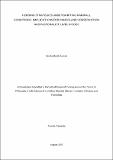| dc.description.abstract | Understanding rainfall variability is of great importance in East Africa, where small-scale
farmers and pastoralists dominate. Factors such as fire, herbivory and soil conditions also
determine the spatial and temporal plant productivity, influencing livestock production and
wildlife sustainability. This study focused on assessing pastoralist herding strategies under
varying rainfall conditions as well as their implications to rangeland conservation and
pastoralist livelihood. I conducted 241 household interviews, collected information from 52
participants of Participatory Rural Appraisal (PRA), and used rainfall archived data from the
Ngorongoro Conservation Area Authority (NCAA) to assess pastoralists’ perception and actual
trends in rainfall, drought frequency, pasture availability, rangeland cover, and livestock
production. I established four exclusion plots of 1 m2
each within an area of 50 x 100 m at eight
sites to quantify the effect of grazing and to estimate grass productivity across season and
elevation. Single and multi-species groups of wild herbivores were recorded along road
transects in human-dominated landscapes of the Ngorongoro Conservation Area (NCA) in two
sampling periods (wet season: November–May and; dry season: June–October) in 2018-2019.
Most (71%) pastoralists were aware of general climate change, rainfall variability, and impacts
of extreme events on their livestock. The exclusion plots showed that aboveground primary
productivity and recovery from grazing was driven by both rainfall (F3, 4 = 19.165, p < 0.0001)
and elevation (F2, 3 = 11.319, p = 0.023). Wild herbivore group sizes (Mean ± SE) were larger
during the wet (7 ± 1 browsers, 19 ± 2 grazers and 19 ± 3 mixed feeders) than during the dry
season (3 ± 0 browsers, 13 ± 1 grazers and 13 ± 4 mixed feeders) and varied seasonally with
distance to Ngorongoro crater, streams, and human settlements. The study concludes that
rainfall variability and recurrent droughts are the major challenges to livestock production in
NCA. Moreover, increasing livestock population and high dependence on grazing resources
impact the potential of the rangeland to support livestock and wildlife. The study recommends
that wildlife coexistence is crucial for the protection status of this man-and-biosphere reserve,
however, the management should determine the optimal resource ratio and the level of stocking
densities the rangeland can support. | en_US |

